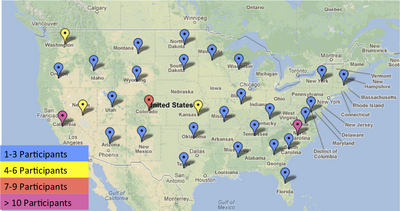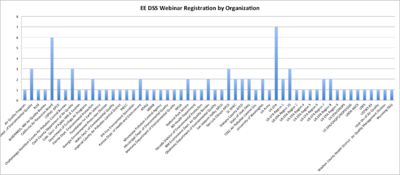Difference between revisions of "EE DSS Webinar"
| Line 5: | Line 5: | ||
=== Webinar Outline === | === Webinar Outline === | ||
The hour and a half webinar will have three parts: | The hour and a half webinar will have three parts: | ||
| + | # What are exceptional events? | ||
| + | ## Description of steps (1) state observation (2) compare to standard - Ozone (daily max), PM2.5 (daily max, yearly average), PM10 (daily max) (3) Four steps that mgmt has to consider | ||
| + | # We have tool set that are nationally applicable for both flag id and documentation therefore there is a decision support system that is to be applicable to any of the exceedance types, regardless of cause, pollutant, and of region. | ||
| + | # Identify two dates flag submission (July 1) and documentation submission (Dec. 15) | ||
| + | # Priority is on screening for flagging event and what is the potential cause - categories | ||
# Intro to the EE DSS by Rudy Husar, Washington University; | # Intro to the EE DSS by Rudy Husar, Washington University; | ||
| + | |||
| + | |||
| + | |||
| + | |||
# Hands-on session to try the EE DSS for your own State; | # Hands-on session to try the EE DSS for your own State; | ||
# Wrap-up Q&A | # Wrap-up Q&A | ||
Revision as of 11:44, April 15, 2013
< Exceptional Air Pollution Event Analysis Community Workspace | Discussion | News | Participants | About
This webinar is focused on screening the AQS data for exceedances above "normal" values using the Exceptional Event Decision Support System (EE DSS). Based on this screening, States can identify candidate samples for EE flagging.
Webinar Outline
The hour and a half webinar will have three parts:
- What are exceptional events?
- Description of steps (1) state observation (2) compare to standard - Ozone (daily max), PM2.5 (daily max, yearly average), PM10 (daily max) (3) Four steps that mgmt has to consider
- We have tool set that are nationally applicable for both flag id and documentation therefore there is a decision support system that is to be applicable to any of the exceedance types, regardless of cause, pollutant, and of region.
- Identify two dates flag submission (July 1) and documentation submission (Dec. 15)
- Priority is on screening for flagging event and what is the potential cause - categories
- Intro to the EE DSS by Rudy Husar, Washington University;
- Hands-on session to try the EE DSS for your own State;
- Wrap-up Q&A
Resources
Webinar Details and Registration
Topic: Exceptional Event Documentation Training
Host: CAPITA at Washington University, ESIP Federation AQ Workgroup
Date: Tuesday, April 30, 2013
Time: 3:00 pm, Eastern Daylight Time (New York, GMT-04:00)
Session Number: 920 523 275
To register for this training session
Go to https://esipfed.webex.com/esipfed/k2/j.php?ED=222698102&UID=1560585307&HMAC=6a9d5b20eee6a53faab07902334301cbbdf01cc1&RT=MiMxMQ%3D%3D&FM=1 and register.
Once you are approved by the host, you will receive a confirmation email with instructions for joining the session.

